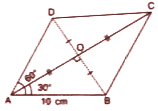A rhombus of side 20cm has two angles of 600 each. Find the length of the diagonals.
To find the lengths of the diagonals of a rhombus with a side length of 20 cm and two angles of 60 degrees each, we can follow these steps:
Step 1: Understand the properties of the rhombus
A rhombus has the following properties:
- All sides are equal.
- The diagonals bisect each other at right angles (90 degrees).
- The diagonals also bisect the angles of the rhombus.
Step 2: Label the rhombus
Let's label the rhombus as ABCD, where:
- AB = BC = CD = DA = 20 cm (sides of the rhombus)
- ∠A = ∠C = 60 degrees
- ∠B = ∠D = 120 degrees (since the sum of angles in a quadrilateral is 360 degrees)
Step 3: Find the angles formed by the diagonals
The diagonals bisect the angles of the rhombus:
- Therefore, ∠AOB = ∠AOD = 30 degrees (since ∠A = 60 degrees, and it is bisected)
Step 4: Use triangle properties
Let the diagonals AC and BD intersect at point O.
- We know that AO = OC and BO = OD (because diagonals bisect each other).
Step 5: Apply the sine rule in triangle AOB
In triangle AOB, we can use the sine function:
- We know that AB = 20 cm (hypotenuse), and we need to find OB (half of diagonal BD).
- Using the sine of angle AOB (30 degrees):
sin(30∘)=OBAB
Step 6: Substitute values
We know that:
- sin(30∘)=12
- AB = 20 cm
Substituting these values into the equation gives us:
12=OB20
Step 7: Solve for OB
Cross-multiplying gives:
OB=20×12=10 cm
Step 8: Find the length of diagonal BD
Since OB = OD, the length of diagonal BD is:
BD=2×OB=2×10=20 cm
Step 9: Apply the cosine rule in triangle AOB
Now, we can find OA (half of diagonal AC) using the cosine function:
- Using the cosine of angle AOB (30 degrees):
cos(30∘)=OAAB
Step 10: Substitute values
We know that:
- cos(30∘)=√32
- AB = 20 cm
Substituting these values into the equation gives us:
√32=OA20
Step 11: Solve for OA
Cross-multiplying gives:
OA=20×√32=10√3 cm
Step 12: Find the length of diagonal AC
Since OA = OC, the length of diagonal AC is:
AC=2×OA=2×10√3=20√3 cm
Final Answer
The lengths of the diagonals are:
- BD = 20 cm
- AC = 20√3 cm
A rhombus has the following properties:
- All sides are equal.
- The diagonals bisect each other at right angles (90 degrees).
- The diagonals also bisect the angles of the rhombus.
Let's label the rhombus as ABCD, where:
- AB = BC = CD = DA = 20 cm (sides of the rhombus)
- ∠A = ∠C = 60 degrees
- ∠B = ∠D = 120 degrees (since the sum of angles in a quadrilateral is 360 degrees)
The diagonals bisect the angles of the rhombus:
- Therefore, ∠AOB = ∠AOD = 30 degrees (since ∠A = 60 degrees, and it is bisected)
Let the diagonals AC and BD intersect at point O.
- We know that AO = OC and BO = OD (because diagonals bisect each other).
In triangle AOB, we can use the sine function:
- We know that AB = 20 cm (hypotenuse), and we need to find OB (half of diagonal BD).
- Using the sine of angle AOB (30 degrees):
sin(30∘)=OBAB
We know that:
- sin(30∘)=12
- AB = 20 cm
Cross-multiplying gives:
Since OB = OD, the length of diagonal BD is:
Now, we can find OA (half of diagonal AC) using the cosine function:
- Using the cosine of angle AOB (30 degrees):
We know that:
- cos(30∘)=√32
- AB = 20 cm
Cross-multiplying gives:
Since OA = OC, the length of diagonal AC is:
The lengths of the diagonals are:
- BD = 20 cm
- AC = 20√3 cm
Topper's Solved these Questions
Similar Questions
The perimeter of a rhombus is 96 cm and obtuse angle of it is 120°. Find the lengths of its diagonals.
View SolutionIn a rhombus ABCD, length of each side is 10 cm and ∠A=60∘. Find the lengths of its diagonals AC and BD.

View SolutionEach side of a rhombus is 10cm. If one of its diagonals is 16cm find the length of the other diagonal.
View SolutionThe perimeter of a rhombus is 52 cm. If one diagonal is 24 cm, find :
the length of its other diagonal,
View SolutionIn a rhombus of side 10 cm one of the diagonals is 12 cm long. Find the length of second diagonal.
View SolutionThe area of a rhombus is 240 cm2 and one of the diagonals is 16 cm. Find the other diagonal.
View SolutionTwo opposite angles of a rhombus are 60° each. If the length of each side of the rhombus is 8 cm, find the lengths of the diagonals of the rhombus.
View SolutionThe side of a rhombus is 13 cm. if one if the diagonals is 24 cm, find the length of the other diagonal.
View SolutionThe area of a rhombus is 216 sq. cm. If its one diagonal is 24 cm, find :
length of its other diagonal,
View SolutionThe area of a rhombus is equal to the area of a triangle whose base and the corresponding altitude are 24.8cm and 16.5cm respectively. If one of the diagonals of the rhombus is 22cm, find the length of the other diagonal.
View Solution
